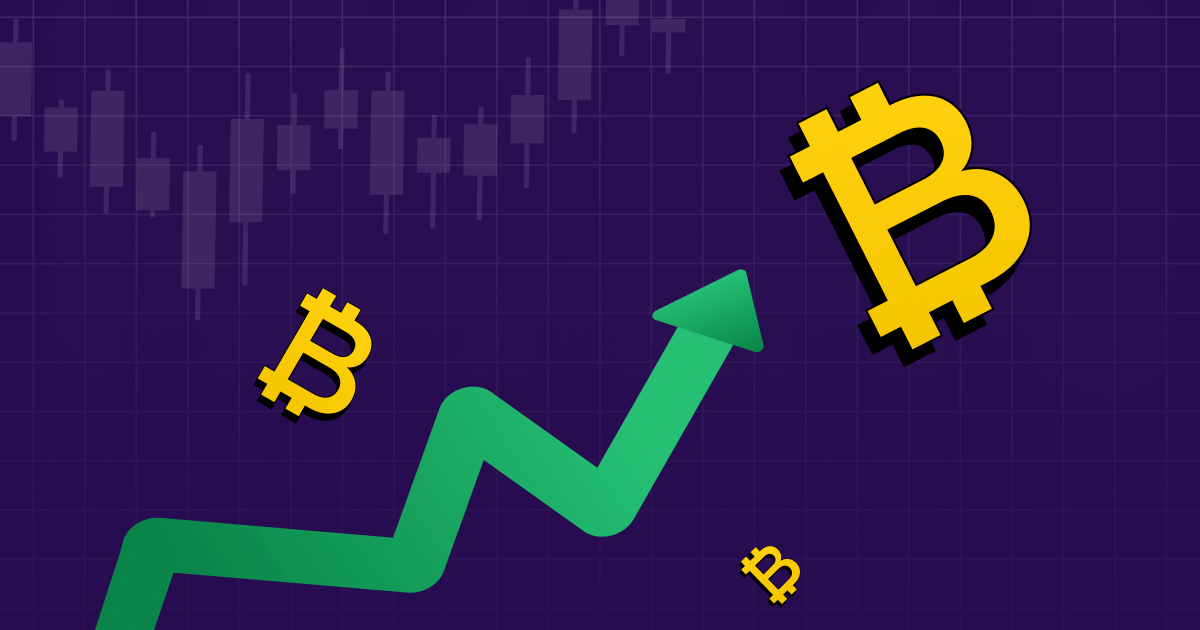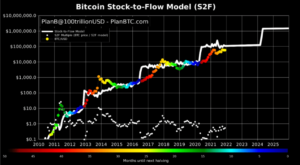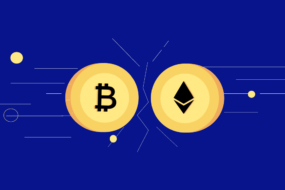
If only it wasn’t the consequence of my own actions. Yeah. You asked for it right? It has been a while since we have been circling the boundaries of this crypto rabbit hole and it’s time that we dive right in. The ‘Stock to flow’ model or S2F is the best way to start this journey. The stock-to-flow model has been a hot topic in the community. Especially, when it comes to Bitcoin. So today, we plan to equip you with the fundamental understanding of this model so that you can nail your next dinner table conversation with the orange pill consumers (that’s Bitcoin believers if you are new here)
Stock-to-flow model is often used to predict the price of Bitcoin and other cryptocurrencies. This is why it has been widely applied to other cryptocurrencies as well. In this post, we talk about what that model is, its pros and cons and how to apply it to predict prices. Let’s go!
Stock-To-Flow Model and Bitcoin – Overview
PlanB, an anonymous investor, introduced the Stock-to-flow or S2F model. This model gained a lot of popularity after being published in 2019. Even the infamous book “The Bitcoin Standard” talks about it.
The entire game of investing revolves around taking a punt at the underlying value of an asset. Please bear in mind that this value is not the current price of that asset. If the value predicted by you is greater than the market price, then the asset price might come down and vice versa.
Stock-to-flow model is a technique to arrive at this value by considering the current supplies and the rate of future production.
In the crypto realm, S2F can be applied to all the assets that derive their value from scarcity, with Bitcoin being the OG player.
Bitcoin is designed in a way that its supply keeps on decreasing. The only way new Bitcoins enter the ecosystem is when miners get them as a reward for validating the transactions. This reward keeps getting halved after every 2,10,000 blocks or roughly four years. Currently, this reward is 6.25 BTC and will go down to 3.125 BTC in 2024.
Historically, the price of Bitcoin has increased with every halving. This is a significant indicator that scarcity-based models like S2F can be applied to the likes of Bitcoin.
S2F has also been applied to precious metals like Gold and Silver to predict their price. However, with technological advancements, it becomes easier to mine these metals. On the other hand, Bitcoin is written in code. There is no way one could create more Bitcoin than intended.
What Is the Stock-To-Flow Model (S2F)?
The stock-to-flow model compares the existing supply of a commodity (Stock) with the future new production (flow). The ratio of these two figures gives us the Stock-to-flow ratio.
Let us understand this with the help of an example. Until this moment, 19,141,856 BTC have been mined. This is 91% of the total supply. The current rate of production stands at 3,28,125BTC per annum. I derived this number by assuming 2,10,000 blocks to be mined every four years and then multiplying the number of blocks each year (52,500) by 6.25, which is the current block reward.
Simply putting these figures in the formula, we get a ratio of 58. This means it would take 58 years to mine all the Bitcoin in circulation today. Please bear in mind that this does not consider the halving event, which would further increase this ratio.
Formula for calculating the stock-to-flow ratio
If mathematics and ratios are not your frens, we would love to simplify it further by writing down the actual formula being used here. And trust me, while they like to call it a model, it is indeed elementary mathematics at its heart.
Stock-To-Flow Ratio (SF) = Stock (Total quantity in circulation for a commodity) / Flow (Annual production of the commodity)
What Are the Advantages of the S2F Model?
As mentioned above, there are several ways to derive a commodity’s value. If that’s the case, why is S2F model so popular? Let us figure that out.
1. Easy to use
Duh! The S2F model does not involve complicated equations to arrive at a number. Anyone with a context of the current supply and production rate can easily arrive at SF.
2. Intrinsic value
Another popular argument against Bitcoin is that it has no intrinsic value. Allow me to explain. When you purchase a stock, you are purchasing the part ownership of a company. This company has revenue, cash flows, etc. Bitcoin? Well, not so much!
It is very similar to gold, whose value is derived purely from scarcity and its usage in jewelry, utensils, etc.
Since it is difficult to predict the value of something that is NOT producing anything tangible, the S2F model offers a perfect opportunity to do the same.
How Can Bitcoin Investors Benefit from Stock-To-Flow Analysis (S2F)?
The S2F model considers the current supply and potential production in the coming years. Therefore, a high S2F ratio, something to the tune of above 50, indicates intense scarcity.
A smart investor might choose to sell at this point and profit from the existing holdings.
On the flip side, if the S2F ratio of Bitcoin is less, one can take positions if the S2F will increase in the future. This method has proven successful in all the past three halving events so far.
As calculated above, the current S2F ratio for Bitcoin stands at 58, and it is likely to jump up near the next halving.
Here’s an actual comparison of the BTC’s market price and the price derived by the S2F model.
As you can see, there is a correlation between the predictions and the actual price. However, as Bitcoin gains popularity, more macroeconomic factors, including its legality, will come into the picture.
P.S. One of the best investment advice is to stop timing the market and focus on time in the market. Use Coin Sets to get access to a curated portfolio managed by experts.
Understanding How to Invest in Crypto Using the Stock-To-Flow Model
Stock-to-flow model is a relative model. That means it should be used in conjugation with other models. However, using the exact same technique as above, you can compare the SF ratio of different cryptocurrencies to see if they are going to appreciate or depreciate.
Please bear in mind that this applies to cryptos with a proven scarcity. Scarcity gives birth to ‘unforgeable costliness.’ In other words, the cost of producing the new units of a commodity becomes so high after the initial discovery that it assigns an intrinsic value to that commodity.
For example, despite appreciating by 20% in 2005-2006, the production of gold remained the same because of technological constraints.
For cryptocurrencies, this constraint can be coded in the design itself. Therefore, it is even more powerful than commodities as they are prone to discovery (high flow) with technological advancement.
Limitations of Stock-To-Flow Model
Well, just like everything else in life, you need to imbibe the stock-to-flow model with a pinch of salt. There are certain limitations of this model that you must understand before applying it.
1. Demand
The S2F model talks about the current supply and the supply rate annually. However, it fails to consider the demand aspect of a commodity/asset. The forces of supply and demand heavily impact cryptocurrency prices. However, the S2F model does not take it into account.
For example, while the next halving would increase Bitcoin’s SF ratio further due to a decrease in flow, it would never appreciate if the demand for Bitcoin falls down. No matter how high the SF ratio is.
2. Black swan events
Another fault in our stars. Black swan events are described as unforeseeable, extremely rare, but possible catastrophic events that cause a significant crash in the price of an asset.
Bitcoin is prone to such events in the form of regulatory crackdowns, 51% attacks, etc.
3. Volatility
Paper hands or the people who panic sell in times of distress can cause the price of Bitcoin to fall. Since cryptocurrency is subject to huge price fluctuations, it is possible that the short-term is impacted by sudden rises or falls in the price. The S2F model does not incorporate any such factor.
Is It Possible to Apply the S2F Model to Other Coins?
The stock-to-flow model applies only to cryptocurrencies with a limited supply or fixed rate of production. Imagine that you apply this model to something like Ethereum. Since the Ethereum foundation runs the entire show, they can literally mint tokens at any time. I am not saying they would, but they could.
In such a case, relying on the S2F model is impossible as the ‘flow’ itself is extremely variable. However, with that being said, other models can be applied to other cryptocurrencies. Investors can gauge the total addressable market and cost of production valuation, assessing the network value to derive the valuation of crypto.
Finally – Should We Follow the S2F Model?
Historically, the S2F model has accurately predicted the price of Bitcoin near every halving event. However, it has been under much scrutiny lately due to the widening gap between the projected value and the actual value of Bitcoin. The price of Bitcoin is currently hovering near the $20K mark, which is a quarter of the $100K predicted by the S2F model.
PlanB predicted that the price of Bitcoin would breach the coveted $1M spot by July 2025. Given that his prediction of hitting $450K by July 2021 has failed miserably, it is quite optimistic to believe these numbers as of now.
But the crypto markets have been extremely volatile by nature. Therefore, it is very difficult to rule out the possibilities laid down by the S2F model.
Apart from that, cryptocurrencies are evolving every single day. Hence, we can expect improved versions of S2F models that consider a wider perspective.
Conclusion
While the S2F model has its limitations, it has done significantly well in forecasting the price of Bitcoin in the past. It is advised to give it a cursory look before forming your narratives and investing in Bitcoin.
FAQs
1. Is Bitcoin stock-to-flow accurate?
Bitcoin’s stock-to-flow model has accurately predicted the price of Bitcoin in the past. While it has certain limitations, one needs to pay attention to this model before forming any strategies for investing in Bitcoin.
2. Does Bitcoin follow stock-to-flow?
Scarcity is embedded in the design of Bitcoin. Therefore, it does follow the stock-to-flow model. In the past, the price of Bitcoin has followed the predictions of the S2F model. However, more macroeconomic factors would come into the picture with the evolving landscape.
3. How is the stock-to-flow model calculated?
Stock-to-flow model is the division of stock (the current supply of a commodity) and flow (the production units in a year). This gives you an SF ratio which would tell you the time required to produce the current supply.





